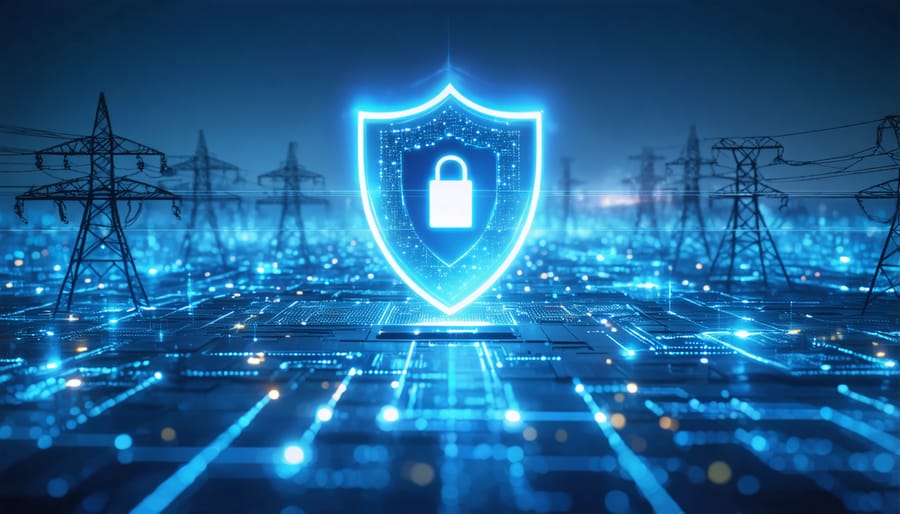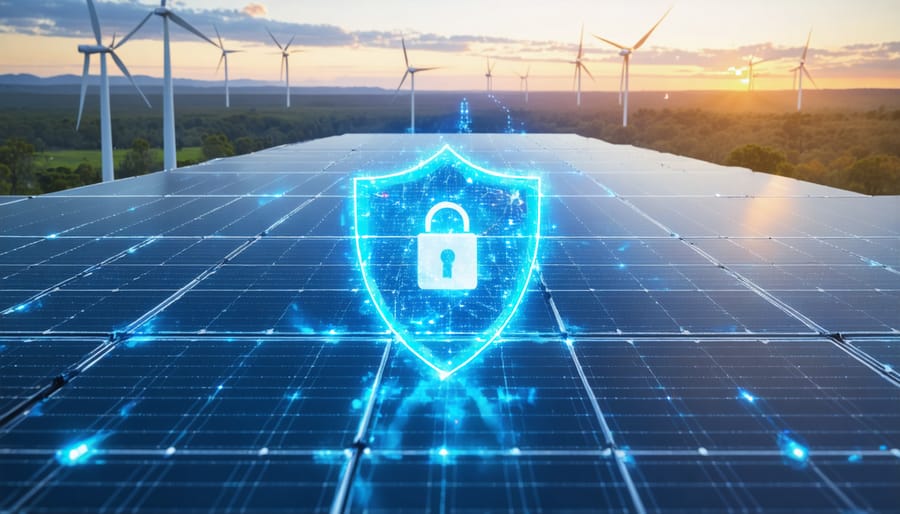In an era where digital threats evolve daily, Australia’s smart energy infrastructure security stands as our critical defense against cyber attacks on power systems. The Office of Cybersecurity, Energy Security, and Emergency Response (CESER) serves as the vanguard of our nation’s energy resilience, wielding cutting-edge technology and expertise to safeguard our increasingly interconnected power networks. As renewable energy systems reshape our grid architecture, CESER’s role has become pivotal in ensuring that our transition to sustainable power remains both secure and reliable. From protecting solar farms against digital intrusions to maintaining the integrity of smart meter networks, CESER’s comprehensive approach combines proactive threat detection, rapid response capabilities, and innovative security protocols that adapt to emerging challenges. This vital organization not only shields our current energy infrastructure but also paves the way for a resilient, sustainable energy future that Australians can trust.
CESER’s Core Mission in Smart Energy Security

Threat Detection and Response
CESER employs a sophisticated multi-layered approach to monitoring and responding to cybersecurity threats in smart energy systems. The organisation utilises advanced threat detection technologies, including artificial intelligence and machine learning algorithms, to continuously scan for potential vulnerabilities and suspicious activities across Australia’s energy infrastructure.
A dedicated team of cybersecurity experts operates 24/7 in real-time monitoring centres, where they analyse data patterns and respond swiftly to emerging threats. This proactive stance helps prevent cyber incidents before they can impact critical energy systems. When threats are detected, CESER’s rapid response protocols kick in, implementing predetermined security measures while coordinating with energy providers and relevant government agencies.
The organisation has also established a robust information-sharing network with international partners, enabling quick alerts about global cyber threats that could affect Australian energy systems. This collaborative approach has proven particularly effective in protecting smart grid infrastructure, with several potential attacks successfully thwarted in recent years.
To stay ahead of evolving threats, CESER regularly updates its detection capabilities and response strategies, incorporating lessons learned from global cybersecurity incidents and emerging attack patterns in the energy sector.
Emergency Response Protocols
In the event of a cyber incident affecting energy infrastructure, CESER’s emergency response protocols swing into action through a well-coordinated, three-phase approach. The initial response phase involves rapid threat assessment and immediate containment measures to prevent cascade failures across the power grid. A dedicated incident response team works around the clock to isolate affected systems while maintaining essential services.
During the stabilization phase, CESER deploys specialized technical teams to implement recovery procedures and restore critical operations. These teams collaborate with local utilities and stakeholders to ensure minimal disruption to energy services. Real-time monitoring systems help track progress and identify potential secondary threats that might emerge during recovery.
The final phase focuses on system restoration and implementing preventive measures. CESER conducts thorough post-incident analysis to strengthen future resilience and shares lessons learned with industry partners. This knowledge-sharing approach has proven particularly effective in protecting Australia’s emerging smart grid infrastructure and renewable energy installations.
To maintain readiness, CESER regularly conducts emergency response drills and updates protocols based on evolving cyber threats and technological advances. This proactive stance ensures our energy infrastructure remains secure and reliable, even in the face of sophisticated cyber attacks.
Protecting Australia’s Smart Grid Infrastructure
Bioenergy Integration Security
Bioenergy facilities require robust security measures to protect against cyber threats while maintaining efficient operations. Modern bioenergy plants utilize sophisticated control systems that monitor everything from feedstock processing to power generation, making cybersecurity a critical priority.
These facilities implement multi-layered security protocols, starting with secure access control systems that restrict both physical and digital entry points. Smart monitoring systems continuously track operational parameters while scanning for potential security breaches, utilizing artificial intelligence to detect unusual patterns that might indicate cyber attacks.
In Australia, leading bioenergy facilities have adopted advanced encryption protocols for their control systems, ensuring that communication between different components remains secure. These measures include regular security audits, real-time threat monitoring, and automated backup systems that can maintain operations during potential security incidents.
A noteworthy innovation is the implementation of isolated networks for critical control systems, creating an “air gap” between sensitive operations and external networks. This approach, combined with regular staff training on cybersecurity best practices, has proven effective in protecting bioenergy infrastructure.
Emergency response protocols are regularly updated and tested through simulation exercises, ensuring that facilities can respond quickly to any security breaches. These protocols include automatic system isolation procedures and redundant control mechanisms that maintain essential operations even under cyber attack conditions.
The integration of these security measures with smart grid technologies allows bioenergy facilities to contribute reliably to Australia’s renewable energy network while maintaining robust protection against evolving cyber threats.

Grid Modernization Security
As Australia advances towards a more sustainable energy future, the security of our smart grid technology integration has become paramount. The transformation of our traditional power infrastructure into an intelligent, connected network brings both opportunities and challenges for cybersecurity.
Our grid modernization initiatives incorporate multiple layers of security measures, including advanced encryption protocols, real-time threat detection systems, and robust authentication mechanisms. These safeguards protect critical infrastructure components while ensuring seamless integration of renewable energy sources into the grid.
Key security features include distributed security architecture, which prevents single points of failure, and automated incident response systems that can identify and neutralize threats before they impact power distribution. Regular security audits and updates ensure the grid remains resilient against evolving cyber threats.
The implementation of these security measures has already shown promising results in pilot programs across various Australian states. For instance, the Smart Grid Security Centre in South Australia has successfully demonstrated how integrated security systems can protect renewable energy infrastructure while maintaining operational efficiency.
Looking ahead, continued investment in grid security technology and training will be crucial as we expand our renewable energy capacity and enhance grid intelligence. This commitment to security ensures that Australia’s transition to smart energy systems remains both sustainable and secure.
Future-Proofing Renewable Energy Security

AI and Machine Learning Applications
In the rapidly evolving landscape of energy security, artificial intelligence and machine learning have become crucial tools for protecting Australia’s smart energy infrastructure. AI-powered grid monitoring systems now serve as vigilant guardians, analyzing millions of data points in real-time to detect potential cyber threats before they can impact operations.
These advanced technologies employ sophisticated algorithms to establish baseline operational patterns, making it possible to identify anomalies that might indicate a security breach. Machine learning models continuously adapt to new threat patterns, providing increasingly accurate threat detection and automated response capabilities.
In smart energy systems, AI applications extend beyond basic security monitoring. They help optimize energy distribution, predict equipment failures, and coordinate responses to potential cyber incidents. These systems are particularly valuable in renewable energy installations, where they help maintain the delicate balance between power generation, storage, and distribution while ensuring cybersecurity protocols remain robust.
The integration of these technologies has proven especially effective in protecting critical infrastructure, with success stories showing up to 85% improvement in threat detection speed compared to traditional methods. This technological evolution represents a significant step forward in securing Australia’s sustainable energy future.
Industry Collaboration Framework
CESER’s success in maintaining energy security relies heavily on its robust industry collaboration framework, bringing together key stakeholders from across the energy sector. Through strategic partnerships with utility companies, technology providers, and infrastructure operators, CESER facilitates real-time information sharing about emerging cyber threats and best practices for protection.
A standout feature of this framework is the Cybersecurity Risk Information Sharing Program (CRISP), which enables participants to share threat data and defensive measures quickly and securely. This collaborative approach has proven particularly effective in Australia, where energy providers work together to protect critical infrastructure across vast distances.
CESER also coordinates regular industry exercises and workshops, simulating cyber incidents to test response capabilities and strengthen coordination between private and public sectors. These exercises help identify potential vulnerabilities and develop practical solutions before real threats emerge.
The framework emphasizes a “mateship” approach to cybersecurity, encouraging energy sector participants to view themselves as partners rather than competitors when it comes to protecting shared infrastructure. This collaborative spirit has resulted in stronger defensive capabilities and more resilient energy systems nationwide.
As Australia embraces a sustainable energy future, CESER’s role becomes increasingly vital in safeguarding our critical infrastructure. Through its comprehensive approach to cybersecurity and emergency response, CESER ensures that our renewable energy systems remain resilient and secure. The organization’s proactive stance in identifying threats, implementing protective measures, and coordinating emergency responses has positioned Australia as a leader in energy security innovation. By fostering collaboration between industry stakeholders, government agencies, and technology experts, CESER continues to build a robust framework that supports our nation’s transition to clean energy. Looking ahead, CESER’s ongoing commitment to protecting our energy infrastructure will be crucial in maintaining public confidence and ensuring the successful integration of sustainable energy solutions across the country. Their work exemplifies how security and sustainability can work hand in hand to create a more resilient and environmentally conscious energy future for all Australians.

